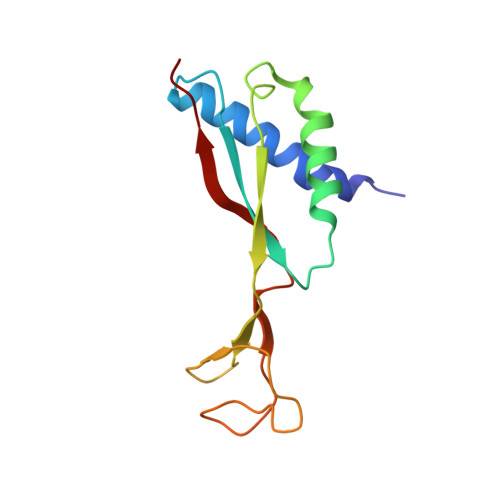Structure of a nickel chaperone, HypA, from Helicobacter pylori reveals two distinct metal binding sites
Xia, W., Li, H., Sze, K.-H., Sun, H.(2009) J Am Chem Soc 131: 10031-10040
- PubMed: 19621959
- DOI: https://doi.org/10.1021/ja900543y
- Primary Citation of Related Structures:
2KDX - PubMed Abstract:
Metallochaperones bind metals and ensure the safe delivery of metals to the targets. They are required for the activation and maturation of nickel-containing enzymes [Ni,Fe]-hydrogenase and urease. Metallochaperone HypA was found to be essential to facilitate nickel delivery to hydrogenase together with its partner HypB, although the detailed mechanism is not clear. In this study, we have cloned hypA gene from Helicobacter pylori (strain 26695), overexpressed, and purified the protein. The zinc-bound HypA (Zn-HypA) exists as a monomer in solution, and its solution structure was determined by NMR spectroscopy together with molecular dynamics simulated annealing. Zn-HypA folds into two domains, including a zinc domain and a nickel domain with a mixed alpha/beta structure. The former houses a rigid zinc-binding site possibly with the role of structural stabilization, whereas the latter harbors a nickel-binding site at the N-terminus. Zinc binds to the four conserved cysteines tetrahedrally as evidenced by (113)Cd NMR spectroscopy, and nickel coordinates with four nitrogens of the protein probably in a square-planar geometry. Low coordination number of Ni(2+) may allow the metal to be readily transferred to its downstream receptors. Our studies may shed light on how the metallochaperone exerts its functions in intracellular nickel delivery.
Organizational Affiliation:
Department of Chemistry and Open Laboratory of Chemical Biology, University of Hong Kong, Pokfulam, Hong Kong, People's Republic of China.















